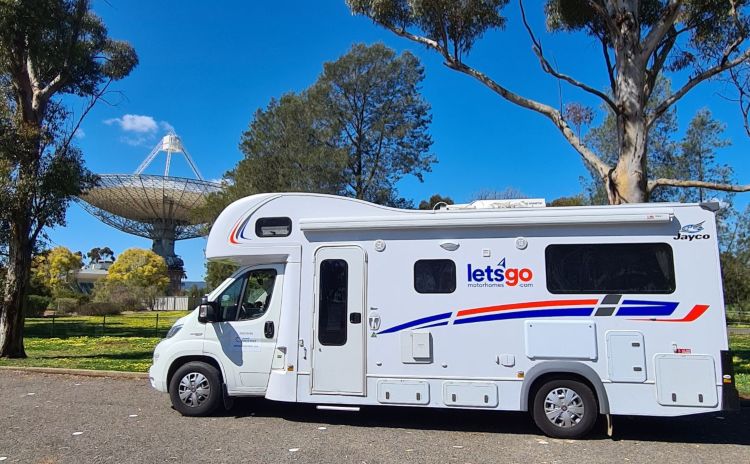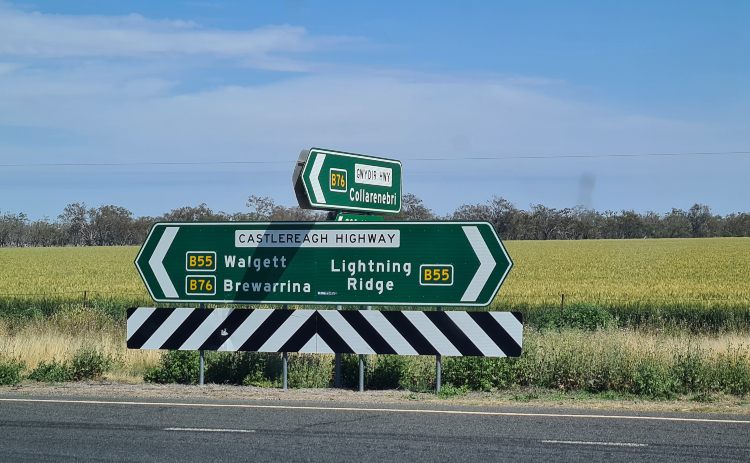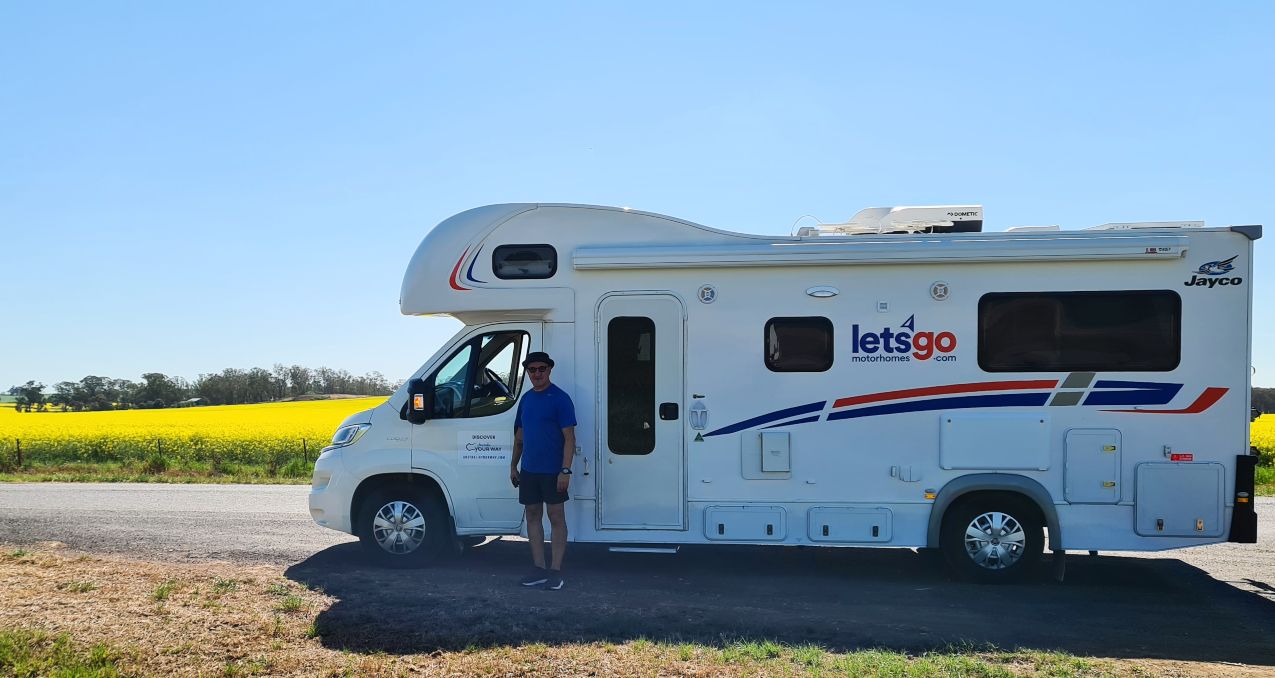If you are thinking about renting a motorhome in Australia and are not sure where to start, we have some tips to help. While we have road-tripped several times, our extended NSW tour last year was the first time we rented a motorhome, and we had lots of questions! We researched for months and then spent five weeks in our rented motorhome; here is what we learned.
This page may contain affiliate links. Read our full disclosure policy for more information.
Everything you need to know before you book a motorhome
Renting a motorhome, also known as an RV (recreational vehicle), for the first time can be daunting. At first thought, things seem simple enough. Book a vehicle and start planning your itinerary. Then you look at hire websites, and the questions begin…
- Do you need a special licence to drive a motorhome or RV? – Short answer no!
- Will I be comfortable in a campervan, or should I splurge on a motorhome?
- Which size vehicle should I book?
- Is there any difference between rental companies?
- What type of insurance do I need? Is it included?
- Should I book a motorhome with a bathroom or toilet?
When we went off on our first motorhome trip last year, we had all these questions and more. I did hours and hours of research before booked and set off on the road. We hope these tips make your decision easier.

A step-by-step guide to choosing which type of RV to Rent
Does size matter? The age-old question, when it comes to your home on wheels, there is no one size fits all.
Deciding what size motorhome or campervan you will be comfortable with is the first thing you need to sort out and there is a lot to consider.
Rental companies offer everything from very compact campervans to motorhomes with 2, 4 or 6 berths. Each of these has its own pros and cons, and the right one for you will depend on your situation and the level of comfort you want.
- Determine the features you want – make a list of must-have and nice to have
- Look at the size of vehicle you need to get your must-haves
- Determine if your trip will take you off-road – ground clearance may be an issue
- Will you be working on the road?
- Are you planning to free camp or will you mostly stay in caravan parks?
Motorhome/RV or Campervan: How do you choose?
The size of the vehicle you choose will determine several things:
- Cost – Campervans are significantly cheaper but often lack the comfort and facilities of a motorhome. For us, this was a longer trip, and we would be working on the road, so we ruled out a campervan quickly.
- Hire options – Campervans are easier to book; there are just more available for rent.
- Where you can take the vehicle – The larger the vehicle, the less freedom you have to go off-road; you also need to be aware of low bridges and roads with weight restrictions. Many motorhomes companies only allow you to take your hire vehicles on sealed or bitumen roads, except for short drives on access roads to camping grounds.
- Your comfort – For our long trip, we wanted a fixed bed that we didn’t have to make up every night. Decide on your deal-breakers before you compare vehicles.

Features you might want to consider
Is there a toilet onboard? This is probably most important if you plan to free camp.
Do you need a shower in your motorhome? We had one and used it when free camping or when we woke to frosty mornings in central NSW.
Is the bed fixed, or do you need to make it every day? We chose a fixed bed because I had a back injury last year and wanted good support. Not having to pack up the dining table and make the bed every day cost us more, but it was a trade-off we were comfortable with.
Does the vehicle have a freezer? It might not seem like it matters, but we found having a decent size freezer helped us save money. We cooked and flat packed a dozen meals and cuts of meat for when we were free camping or in remote areas.
Campervans – Are they right for you?
If you are travelling with a tight budget, then consider campervan hire instead. You can pick one up for 50% less than a motorhome.

Standard campervans rarely come with a fixed bed or a toilet, although this is possible. However, you can find campervans with bathrooms. It cuts into the living space, making it substantially smaller. You will need to do more of your living outdoors and in communal areas, which may or may not be a problem for you.
We were also travelling in winter through central NSW, where temperatures can (and did) drop below freezing at night. The living space in a campervan means you need to do more of your time with the doors open, especially to cook.
I think they can work well for quick trips up to a week, as hundreds of happy backpackers prove every year. If you are a little past that age and want more creature comfort, you might prefer a motorhome. However, campervans can be very cheap and that can be attractive!
Motorhome Sizes
Most rental companies offer 2, 4 and 6 berth vehicles; however, in reality, many of the 4 and 6 berths are the same vehicle with slightly different internal fit-outs.
Vehicle Dimensions
Most motorhomes fit the following ranges:
- Width: 2.3-2.5m wide
- Height: 3-3.3m
- Length: 6-7.6m
The main difference is the length and weight of the vehicle. A six berth motorhome is too long for a regular car space, so you need to park in specific caravan parking or find a spot where you can reverse over the end of the space. We didn’t really find this a problem. You just need to be happy to walk further into town or attractions.

When it comes to weight, you need to keep an eye out on roads that are not suitable for the weight of your van. Some roads restrict vehicles over 3,000kg (or 3t), and while you may get away with driving on these in error, it’s important to know that if you were involved in an accident, your vehicles insurance might not cover you.
How do you decide which size you need?
Still not sure? It can be as simple as this – do you want a fixed bed?
Many 2 and 4 berth campervans do not have a fixed bed. You convert the dining/seating area at the end of each day into your bed. There are exceptions; however, they are hard to find. Also, most companies will not guarantee you a specific layout, so it’s hard to ensure you will get a proper bed.
This is not such a big deal in the summer as you can do almost all your living outside the vehicle and leave the bed made up if you want to. However, as we mentioned above, it can quickly become a pain in cold climates, particularly if you are working and need a desk.
What are the classes you might have heard talked about?
More commonly heard when buying rather than renting, but they sometimes mention these terms.
- A Class – Not common in rental offerings; these include coasters and bus style RVs where the driver’s cabin is integrated into the main vehicle.
- B Class – These are standard looking motorhomes with a flat roof and walk through from driver’s seat to back of the vehicle. Many solo travellers find this an important feature.
- C Class – These are also known as cab chassis – They have an area above the driver’s cabin, giving you more flexibility for storage or sometimes this space is an extra bed, giving you more flexibility with your sleeping arrangements.
Know your route – you need to steer clear of roads that are only for vehicles under 3 tonne. You also need a minimum of 200mm extra clearance over your height.

Hiring a Motorhome in Australia
Motorhome Hire Companies in Australia
There a quite a few motorhome companies, and while there is not a vast difference in the vehicles they offer, some models/features are unique to a specific company. The optional extras and insurance costs also vary.
The main motorhome rental brands in Australia are:
- Apollo – one of the most popular with branches in all capitals, plus Broome and Cairns. They offer four models of Euro Campers on their website, but when we went to view them, they only had two available and said the models with fixed beds had been discontinued. They are at the higher end price-wise in our experience.
- Britz – All capitals plus Alice Springs and Broome
- Cruisin – Cairns, Brisbane, Sydney, Melbourne, Hobart
- Let’s Go – All the capitals plus good regional coverage, including Cairns, Coffs Harbour, Gippsland, or Bendigo.
- Star RV – Apollo’s premium brand
- Maui – All capitals plus Alice Springs and Broome – Rent out Britz and Mighty vehicles
We actually went and inspected motorhomes at each of these offices except Britz; this might sound like overkill, but there were offices within a short drive of our home.
We did not find a tremendous difference in quality, although the layouts and storage on offer varied. By having our list of musts ready, it was easy to shortlist the vehicles we liked best.
There are quite a few smaller operators who rent campervans like JUCY who target the backpacker market. If you are taking a short trip, this can be a great choice.
There are also share economy companies, like Campify, the Airbnb of RV hire.
How to Save Money When You Rent a Motorhome in Australia
There are a number of ways to reduce the cost of your rental but in a post covid world prices have certainly increased. These tips might help.
Travel outside peak periods
The best way to save money by renting your motorhome is to travel outside the peak season. School holidays and long weekends prices can double, much like airline seats, motorhome rental is a supply and demand model. Prices also rise substantially over public holidays.
The time of year that you travel can add up to 50% to your rental cost
Drivenow.com.au
The cheapest months to hire are June to September, with January, February and April May being the most expensive.
Book early
You can also save by booking early – sometimes as much as 10% by booking eight weeks or more in advance.
Be a repeat customer
We were offered a substantial discount on our second rental, so mention it if you are booking again.
Do a short trip by booking a relocation vehicle
A great way to try out motorhome holidays is to book a motorhome relocation, moving a vehicle from one city to another. These can cost as little as $1 a day and average at $5 a day. You will often have 3-7 days to get a motorhome from one city to another, for example, Sydney to Darwin or Alice in 7 days. Sydney to Melbourne in three days.
Some companies even offer a fuel allowance. This is usually a last-minute thing, meaning you can usually only book a few weeks in advance. We have our eyes peeled on Imoove at the moment for an impromptu getaway on a budget.
Consider free and cheap campsites
Australia also has a bunch of RV Friendly towns that are worth keeping in mind when planning your route. RV friendly towns offer short term, low-cost overnight parking, access to drinking water and dump points for free and parking for long vehicles in the town centre.
Limit the Optional Extras
GPS – at first thought you might rule this out, we did, but if you are driving in outback Australia, say to Alice Springs or Sydney to Perth, it would be handy. Even with the best phone plan, reception is patchy, and your Google maps will not be available.
Bikes – If you can ride a bike, this is a great inclusion. Once you have set up your RV and plugged in the power and water, the last thing you want to do is do it all again when you realise you need something from the shop. Most caravan parks and campgrounds are located a kilometre or more from town, so a bike comes in real handy.

Insurance options for your motorhome rental
Like when renting a car, insurance is a huge part of the rental cost for many bookings. It can cost more than the daily rental sometimes. We highly recommend you make sure that the company you rent from will allow you to purchase an external policy.
We discovered Rentalcover.com and our 5-week comprehensive insurance policy that covered everything that the top level at the rental place’s offer was only $442. A fraction of what we would have paid if we had bundled it with the rental plan on offer at the hire company. We have used them twice now and have been thrilled with their lower fees.
Popular motorhome routes in Australia
A motorhome allows you the freedom to go wherever the day takes you; however, some great touring routes in Australia include:
- Great Ocean Road
- Sydney to the Gold Coast and Brisbane
- The inland route from Tenterfield to Lightning Ridge
- Hobart to Launceston
- The Waterfall Way
- Rainforest Way
- Kangaroo Island
- Adelaide to the Flinders Ranges
- The Eyre Peninsula
- Bendigo and Ballarat (The Victorian Goldfields)
We think a motorhome is the best choice for some of these trips as accommodation and even dining options are limited in lots of remote towns. Everything is just so much easier when you have everything you need with you.

What do you need to know before you hit the road?
Make sure you know the road rules for the state you are planning to travel to. While much of it is the same, there are differences if you are from overseas; check out our guide to driving in Australia.
- Roads & Traffic Authority NSW (RTA) – NSW
- VicRoads – Victoria
- Queensland Transport – Queensland
- Transport, Travel and Motoring – South Australia –
- Department of Transport – Western Australia
- Motor Vehicle Registry – Northern Territory
- Department of Infrastructure, Energy & Resources – Tasmania
- Rego ACT – Australian Capital Territory
We hope this helps you choose the right vehicle for your getaway, but if you have questions, please pop over to our Facebook group and we would be happy to help.
Got a question? Head over to our Australia Travel Tips Facebook Group and ask a local.

